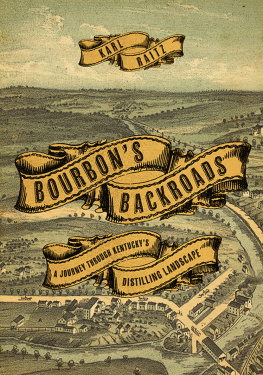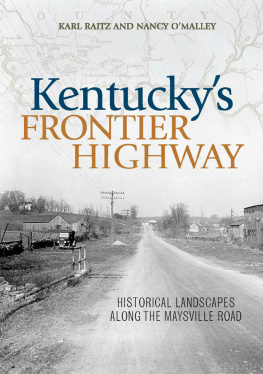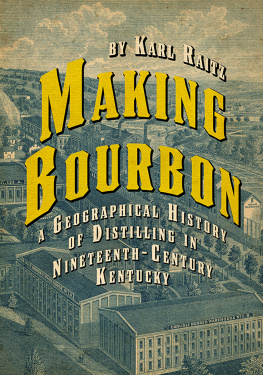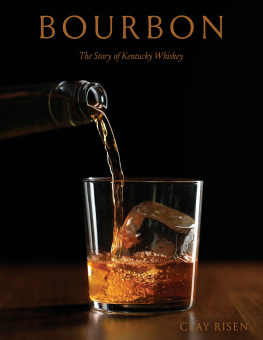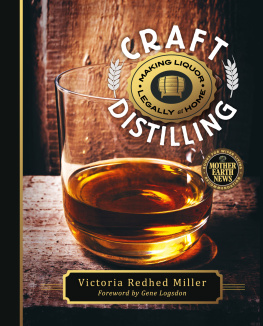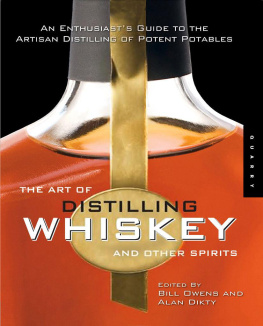
Bourbons Backroads
Bourbons Backroads
A Journey through Kentuckys Distilling Landscape
Karl Raitz
Cartographic Design and Production by Dick Gilbreath, Gyula Pauer Center for Cartography and GIS

Due to variations in the technical specifications of different electronic reading devices, some elements of this ebook may not appear as they do in the print edition. Readers are encouraged to experiment with user settings for optimum results.
Published by South Limestone Books
An imprint of the University Press of Kentucky
Copyright 2019 by The University Press of Kentucky
All rights reserved.
Editorial and Sales Offices: The University Press of Kentucky
663 South Limestone Street, Lexington, Kentucky 40508-4008
www.kentuckypress.com
Unless otherwise noted, photographs are from the authors collection.
Library of Congress Cataloging-in-Publication Data
Names: Raitz, Karl B., author.
Title: Bourbons backroads : a journey through Kentuckys distilling landscape / Karl Raitz.
Description: Lexington, Kentucky : South Limestone Books, [2019] | Includes bibliographical references and index.
Identifiers: LCCN 2019024294 | ISBN 9780813178424 (hardcover) | ISBN 9780813178448 (pdf) | ISBN 9780813178455 (epub)
Subjects: LCSH: Bourbon whiskeyKentuckyHistory. | DistilleriesKentuckyHistory. | Distilling industriesKentuckyHistory.
Classification: LCC TP605 .R35 2019 | DDC 338.4/7663509769dc23
This book is printed on acid-free paper meeting the requirements of the American National Standard for Permanence in Paper for Printed Library Materials.
Manufactured in the United States of America.
for Carol
Contents
Introduction
Bourbon, Kentuckys signature spirit, can be defined with some precision. It is a type of whiskey made primarily from corn, with rye or wheat as a secondary grain; adding small amounts of malted barley increases the efficiency of the fermentation process. A federal law decreed in 1964 that the term bourbon refers to a spirit distilled at no more than 160 proof from a fermented mash of not less than 51 percent corn and stored at no more than 125 proof in new, charred oak barrels. Spirits so produced can legally be identified as bourbon whiskey.1
The term backroads is less precise. Its meaning is prescribed not by law but by convention. A backroad is any lesser-used overland route that traverses countryside and connects places that constitute the fundament of the local and regional culture and economy. Residents of backroads country are dependent on it; appreciative outsiders find backroads of interest in part because they reveal how places work. Backroads pass through landscapes where people conduct their lives; these landscapes contain the natural environments, structures, farms, fields, towns, and industries from which these people earn their living. Backroads can also be interpreted metaphoricallyas historical places that possess venerated traditions, or as the backstory behind how something is made, how it works, the form it takes, and how it came to occupy the place (actual or perceptual) where it now resides. In short, the backstory explains how landscapes are made. This book is about one of Kentuckys signature industries: whiskey distilling. It is also about the landscape the industry created and the heritage it represents.
Bourbons Backroads can be read in the traditional way: simply retire to an armchair and read about how distillers make that bright amber liquid in the cut-glass tumbler standing on your side table. Alternatively, you can use the book as a guide to visit and experience the places where bourbons heritage was made: distilleries long standing, relict, razed, or brand new; distillers homes on Main Street; villages and neighborhoods where laborers lived; storage warehouses on Whiskey Row; river landings and railroad yards; and factories where copper distilling vessels and charred white oak barrels are made. Reading the story of fine bourbon distilling can be engrossing; standing in the landscape where it began and continues to thrive is akin to participating in an interactive theater performance!
, The Lands of Fine Whiskey Distilling, contains three regional chapters that offer insight into the variety of opportunities and possibilities available in different environmental contexts. Why did whiskey distilling grow into one of the states signature industries? Why were some regions attractive to large-scale commercial distilling, while others were not? How has all this been recorded on the landscape, whether in modern-day distilleries, vacant and aging warehouses that have been converted to business offices, or grain elevators that have found new life as restaurants? The answers await on the backroads.
I
Making Bourbon, Making Landscapes
Kentuckys Distilling Heritage
American spirits distilling grew from European and colonial traditions. New England distillers, among them John Hancock and Samuel Adams, made rum out of fermented Caribbean molasses to supply local tipplers with spirituous drink, to stock merchant and whaling ships with the makings for grog, and to serve as currency in the Triangular Trade.1 In the Middle Colonies, German settlers on southeastern Pennsylvanias Piedmont and in the adjacent Maryland counties distilled spirits from rye, as did George Washington in eastern Virginia. Protestant Scots-Irish from Irelands Ulster country and Catholic Irish immigrants brought a thousand-year-old whiskey-making tradition to western Pennsylvania and the Ohio River Valley in the trans-Appalachian West.2 In 1794, upon finding themselves subject to federal enforcement of Alexander Hamiltons excise tax on the whiskey they made, some 2,000 farmer-distillers in western Pennsylvania migrated west, many of them to Kentucky.3 These Whiskey Rebellion refugees reinforced frontier Kentuckys rapidly developing distilling economy.
Pioneers and innovators are often cited in the legends and lore that constitute a founding myth as being the first to accomplish something. Evan Williams, Elijah Craig, and other eighteenth-century Kentucky distillers are often so acknowledged, but absent definitive documentation, only general recognition can be given. It is sufficient to know that distilling was commonplace in 1780s Kentucky.4 Second-generation distillers were providentially positioned to see their accomplishments recorded as literacy rates increased, personal travel reduced isolation, and communication improved with the establishment of local newspapers. Accordingly, the contributions of James C. Crow are more fully understood and illustrate how a talented individual influenced the development of quality whiskey. To him, more than any other man, is due the international reputation that Kentucky enjoys, and the vast distilling interests of the country are largely the result of his discoveries, pronounced a New York publication in 1897.5 Crow was born in Dirleton, Scotland, in 1779. A Presbyterian of the John Knox type, he graduated from the College of Medicine and Surgery in Edinburgh in 1822, trained as a physician and a chemist. The following year he moved from Philadelphia to Kentucky, where he entered the distilling business on Glenns (also spelled Glens or Glenns) Creek, near Millville in Woodford County. Distilling at the time was rarely directed by rules; nor was it exacting in terms of quantity and proportion of ingredients, critical temperatures, or precise timing. Though his still house had a very limited capacityonly two to two and a half gallons per dayby embracing chemistry as a hobby and experimentation as a practice, Crow applied scientific method and advanced instrumentation to his distilling practice. Eventually, he was able to consistently produce a superior corn spirit and, in the process, changed whiskey distilling from an idiosyncratic folk craft to something resembling a science. Brisk sales soon followed, and Henry Clay, Andrew Jackson, William Henry Harrison, and Daniel Webster were among his better-known customers.6
Next page
